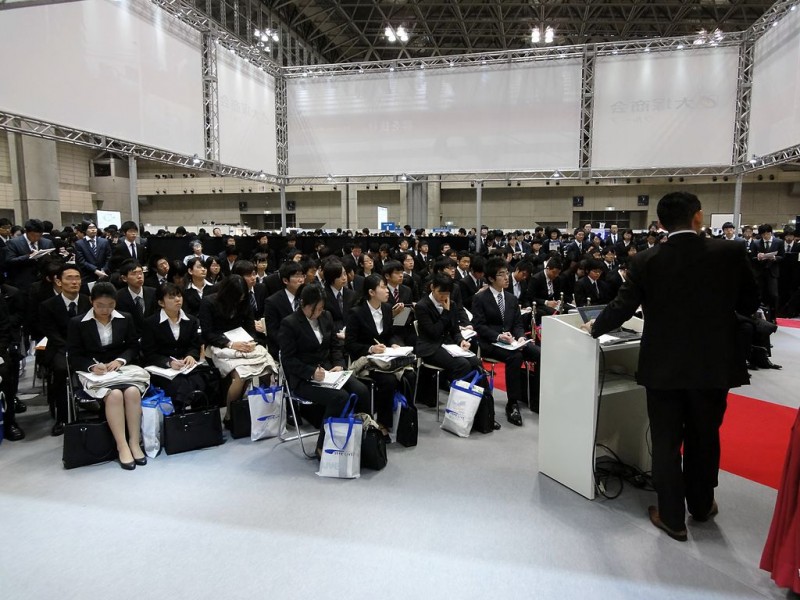
Japanese postsecondary students at a job fair. Caption reads: “Postsecondary graduate employment rate (as of April 1st, 2015): 96.7% (2.3 percentage higher than 12 months ago); fourth year of growth.” Screencap courtesy ANN News.
According to a recently released report [1] by Japan's Ministry of Education (MEXT [2]), 96.7 percent of postsecondary students who graduated in March 2015 were employed by April 1 and the start of the 2015 fiscal year.
The April 1, 2015 employment figures are up 2.3 percentage points compared to one year earlier and mark the fourth straight year of improvement in Japan's employment rate for post-secondary graduates.
The figures are based on a survey conducted by Japan's Ministry of Labor and Ministry of Education [3]. The two ministries surveyed students at 62 universities, junior colleges and technical institutes all over Japan.

Job fairs are typically held in spring and early summer. By fall employers have typically made offers for positions starting the following April. Image: Dick Thomas / Wikimedia [4].
In fact, 100 percent of technical college [5] graduates (students enroll in these colleges at the age of 15 for a five-year program, typically graduating with a technologist certification) who were surveyed reported being able to find work that started in April 2015.
Japan's youth employment rate has remained weak for two decades since the end of the Japanese “Bubble Economy” [6] and as the country, like most other Organisation for Economic Co-operation and Development (OECD [7]) countries, has continued with its demographic shift to an ageing population with weaker demand for goods and services.
The April 2015 employment rate of 96.7 percent for new post-secondary graduates has actually surpassed the 2008 employment rate, just prior to the “Lehman Shock” [8] and the long global downturn that essentially resulted in a hiring freeze in Japan for more than half a decade.
Following a downturn and near economic collapse in many Western countries, just 91 percent of new post-secondary graduates [9] in Japan had secured jobs by April 2011.
Some regions have yet enjoy the benefits of post-Lehman Abenomics [10] and stimulus spending. Okinawa, an isolated island prefecture that has traditionally lagged behind Japan in terms of economic development, reported the worst new graduate employment rate of just 88.4 percent in April 2015 [3].
The years since the Lehman Shock have been known in Japan as an “employment ice age”, where fewer employers were hiring new graduates. Young job seekers who managed to secure coveted salaried positions were forced to accept less-than-ideal working conditions. Others could find only part-time, contract work often for very low wages, while other youth withdrew from the labour market completely.
Now the advantage appears to have shifted from employers to job seekers, which may mean Japanese wages are finally set to rise after nearly 20 years of stagnation.
The April 2015 government employment report also noted that employment rate for new high school graduates was also especially strong.
Indeed, in the three neighbouring rural prefectures of Toyama, Ishikawa and Fukui [11], 99.8-99.9 percent of high school graduates reported they were able to find employment immediately after graduation.
The Hokuriku Shinkansen is now extended from Nagano to Kanazawa! http://t.co/qjXmIYKiJo [12] pic.twitter.com/9Q6QIxAdy1 [13]
— Tokyo Orientations (@TKOrientations) May 15, 2015 [14]
The extremely high employment rate for high school graduates is said to be a result of major infrastructure projects in the region.
These infrastructure projects include the Hokuriku Shinkansen high speed rail line that connects the regional center of Kanazawa with the metropolis of Tokyo. In fact, out of 2,070 high school graduates in Toyama, which lies along the newly constructed high speed rail route, just three individuals reported not being able to find work:
富山の就職率99.9%で今年全国トップらしいね、さすがやで富山~(3人どうした…) — ゆうせい_ts&ae (@te_yuusei) May 19, 2015 [15]
The employment rate for 2015 high school grads is 99.9 percent in Toyama Prefecture. Of course we're the best in the country… but what happened to the other three who couldn't find a job?
Public works projects have likely boosted employment in many regional and rural areas as cheap money floods Japan, a result of the central government's efforts to double Japan's monetary base [16] and ignite inflation.
The new Hokuriku Shinkansen line has also attracted a flood of tourists to Toyama and Ishikawa, boosting employment in tourism.
The April employment figures may also mark a turning point for rural prefectures, including Toyama, that have traditionally lost population to larger urban centers such as Tokyo.
なんか富山帰りたくなってきた…もう就職も富山でしよ…
— よこたま (@ppoollkk1) May 19, 2015 [17]
This makes me want to go back to Toyama! Now I can look for work there too!
For many job seekers in Japan, the hunt for a job after graduation starts early in their final year of school (the school year in Japan ends in March).
The Japan Keizai Shimbun reports [9]:
内定を出し始める時期は4~8月が全体の約8割を占めた。月別にみると6月が19.7%で最も多かった。
About 80 percent of applicants typically receive tentative offers from employers (naitei, 内定) between April and August (more than half a year before graduation). About 20 percent of offers come in June.

Orientation for new salaried employees in early April. Image: Dick Thomas / Wikimedia [4]
Many successful job seekers are quick to post to social media about their success:
二つ目の内定きたーー!
— codeA(就活生) (@xxcodeAxx) May 20, 2015 [18]
I just go my second job offer!
内定3社目いただきました! いい感じに進んできたなー♪ヽ(´▽`)/
— むらっち (@mrtky_1029) May 18, 2015 [19]
I just got my third job offer! Things are going my way!
The strong job market in spring 2015 has resulted in a slight backlash on social media against “job offer bragging” (naitei jiman, 内定自慢), where job seekers boast about how many offers they have managed to accumulate during their job search:
内定自慢やめろ
— ばいすぅ@まあめいる (@soudanagasaki) May 20, 2015 [20]
Cut it out with your bragging about your job offers
The experience of graduating and securing a job can be bittersweet:
内定が出てから一部の友達との関係がほんの少しギクシャクしだした。自分が天狗になって嫌なヤツになっているのかもしれない。
— らくがき (@rykbonk) July 1, 2013 [21]
Once I got my job offer I kind of fell out with some of my friends. I wonder if I bragged too much and became irritating to be around.